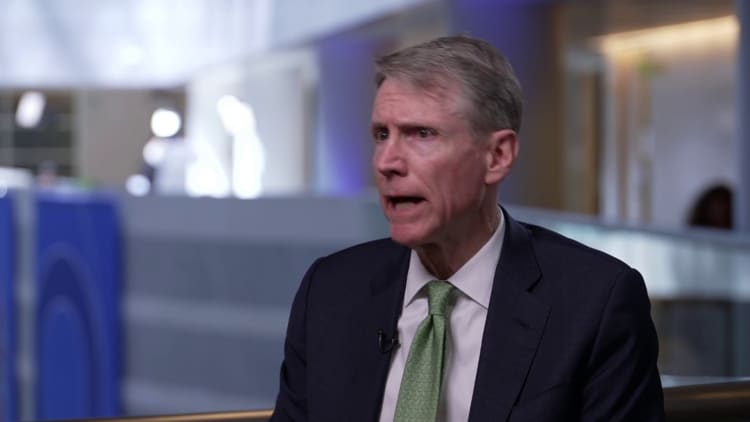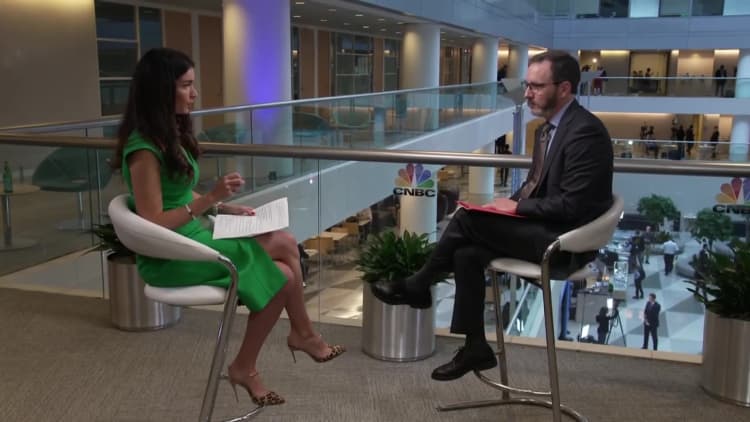
Tim Adams
Anjali Sundaram | CNBC
The banking sector turmoil that led to the collapse of several lenders was not a systemic crisis and has now subsided, according to Tim Adams, CEO of the Institute of International Finance.
The fall of Silicon Valley Bank in early March — the largest banking failure since the global financial crisis — triggered a wave of market panic that swept through the sector in Europe and the U.S.
A flight of shareholders and depositors culminated in the downfall of Credit Suisse, with Swiss authorities brokering the emergency rescue of the 167-year-old institution by domestic rival UBS.
The smaller Signature Bank was closed by regulators stateside, while Wall Street giants stepped in to make $30 billion of deposits at First Republic, buying the regional lender time to establish a survival plan.
Markets have since stabilized, leading many to conclude that the problems were unique to the stricken banks and do not pose a systemic risk. However, the ripple effect has dented the economic outlook in many advanced economies.
Speaking to CNBC on the sidelines of the International Monetary Fund Spring Meetings in Washington D.C. on Tuesday, Adams said the March chaos was a “period of market turmoil or turbulence,” but dismissed the notion that it was a “crisis.”

“We have over 4,000 banks in the United States, we have about 10,000 banks globally that are part of SWIFT and 35,000 financial institutions around the world — 99.999% of them opened their doors over the past month and had no problems whatsoever — [it’s] really just a few isolated idiosyncratic institutions,” Adams told CNBC’s Joumanna Bercetche.
“So I think it is not a crisis, I think it was market turbulence, it has subsided, it has stabilized, but we need to be vigilant and we need to watch for other stresses in the system.”
The IIF is a global trade body for the financial services industry, with around 400 members in more than 60 countries. Adams said the primary concern among members was the downside risk to growth, particularly in advanced economies.
The IMF on Tuesday lowered its five-year global growth forecast to around 3%, marking the lowest medium-term forecast in an IMF World Economic Outlook report since 1990.
The D.C.-based institution’s Chief Economist Pierre-Olivier Gourinchas told CNBC on Tuesday that the turmoil in the banking sector had weakened the growth outlook, especially in the face of rapid monetary policy tightening from central banks that have sharply increased lenders’ funding costs and increased vulnerabilities.

“There are risks, there are geopolitical risks which we can talk about, but the downside risks are real and we just don’t know how deep they are,” Adams said.
“The Fed’s going to probably tighten again, we have other central banks in Europe and the U.K. tightening, so there are risks to the downside.”
Regulators in the U.S. and Europe took swift action to quash contagion risk in the face of the various banking collapses last month. However, U.S. Treasury Secretary Janet Yellen asserted on Tuesday that the banking system remains well capitalized, with ample liquidity.
Adams suggested many of the regulators he had spoken to, including those involved in developing the Dodd Frank and Basel III frameworks in the aftermath of the financial crisis, did not believe major regulatory changes were necessary this time around.
“It’s a very different system than [what] was prevailing in 2007, 2008. I do think we need to better understand what went wrong at certain institutions like SVB, I think we do need to ask what happened to supervision, but I don’t think we’re going to see regulatory changes,” he added.
